Health and Social Care Report: NHS Change Management Strategies
VerifiedAdded on 2022/08/27
|15
|4826
|18
Report
AI Summary
This report delves into change management strategies within the National Health Service (NHS), examining its aims, objectives, and relevant policy provisions and legislation. It analyzes previous interventions and various leadership styles, including autocratic, democratic, and transformational approaches. The report focuses on applying change models, particularly John Kotter's model, to address specific change opportunities within the NHS, such as improving primary care services. It covers creating urgency, building coalitions, communicating visions, removing obstacles, and securing short-term wins. Furthermore, the report explores the impact of change on corporate culture and evaluates the effectiveness of the applied change management strategies. The report provides insights into NHS current statistics and the use of data and technology to reshape the NHS system. It addresses how effective management can enhance service access and provision of information. The report also includes detailed discussion on change models and frameworks and how the previous investments and initiatives have an important impact on daily patient experiences and limited impact on NHS working practices.

Running Head: HEALTH & SOCIAL CARE
0
HEALTH & SOCIAL CARE
0
HEALTH & SOCIAL CARE
Paraphrase This Document
Need a fresh take? Get an instant paraphrase of this document with our AI Paraphraser
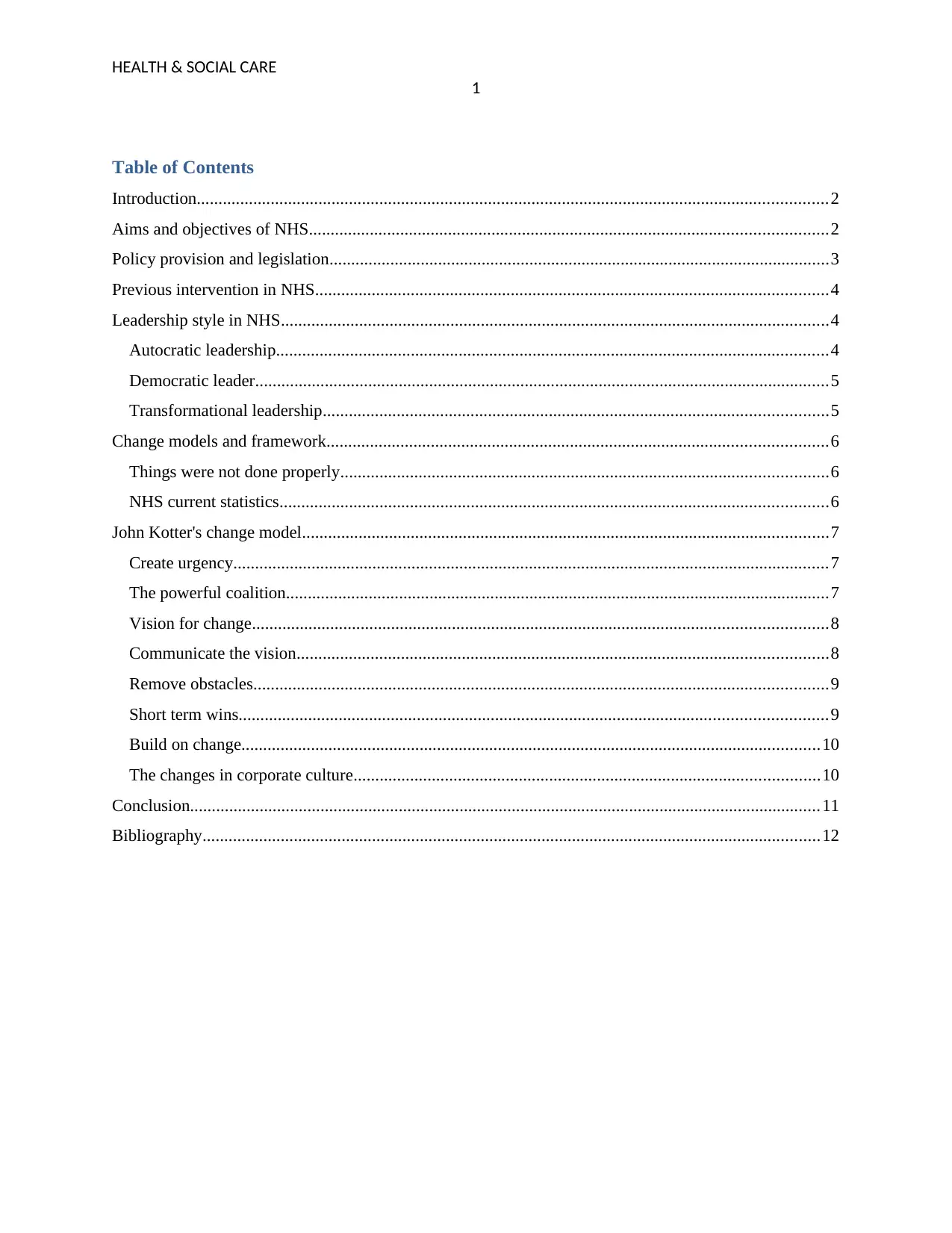
HEALTH & SOCIAL CARE
1
Table of Contents
Introduction.................................................................................................................................................2
Aims and objectives of NHS.......................................................................................................................2
Policy provision and legislation...................................................................................................................3
Previous intervention in NHS......................................................................................................................4
Leadership style in NHS..............................................................................................................................4
Autocratic leadership...............................................................................................................................4
Democratic leader....................................................................................................................................5
Transformational leadership....................................................................................................................5
Change models and framework...................................................................................................................6
Things were not done properly................................................................................................................6
NHS current statistics..............................................................................................................................6
John Kotter's change model.........................................................................................................................7
Create urgency.........................................................................................................................................7
The powerful coalition.............................................................................................................................7
Vision for change....................................................................................................................................8
Communicate the vision..........................................................................................................................8
Remove obstacles....................................................................................................................................9
Short term wins.......................................................................................................................................9
Build on change.....................................................................................................................................10
The changes in corporate culture...........................................................................................................10
Conclusion.................................................................................................................................................11
Bibliography..............................................................................................................................................12
1
Table of Contents
Introduction.................................................................................................................................................2
Aims and objectives of NHS.......................................................................................................................2
Policy provision and legislation...................................................................................................................3
Previous intervention in NHS......................................................................................................................4
Leadership style in NHS..............................................................................................................................4
Autocratic leadership...............................................................................................................................4
Democratic leader....................................................................................................................................5
Transformational leadership....................................................................................................................5
Change models and framework...................................................................................................................6
Things were not done properly................................................................................................................6
NHS current statistics..............................................................................................................................6
John Kotter's change model.........................................................................................................................7
Create urgency.........................................................................................................................................7
The powerful coalition.............................................................................................................................7
Vision for change....................................................................................................................................8
Communicate the vision..........................................................................................................................8
Remove obstacles....................................................................................................................................9
Short term wins.......................................................................................................................................9
Build on change.....................................................................................................................................10
The changes in corporate culture...........................................................................................................10
Conclusion.................................................................................................................................................11
Bibliography..............................................................................................................................................12
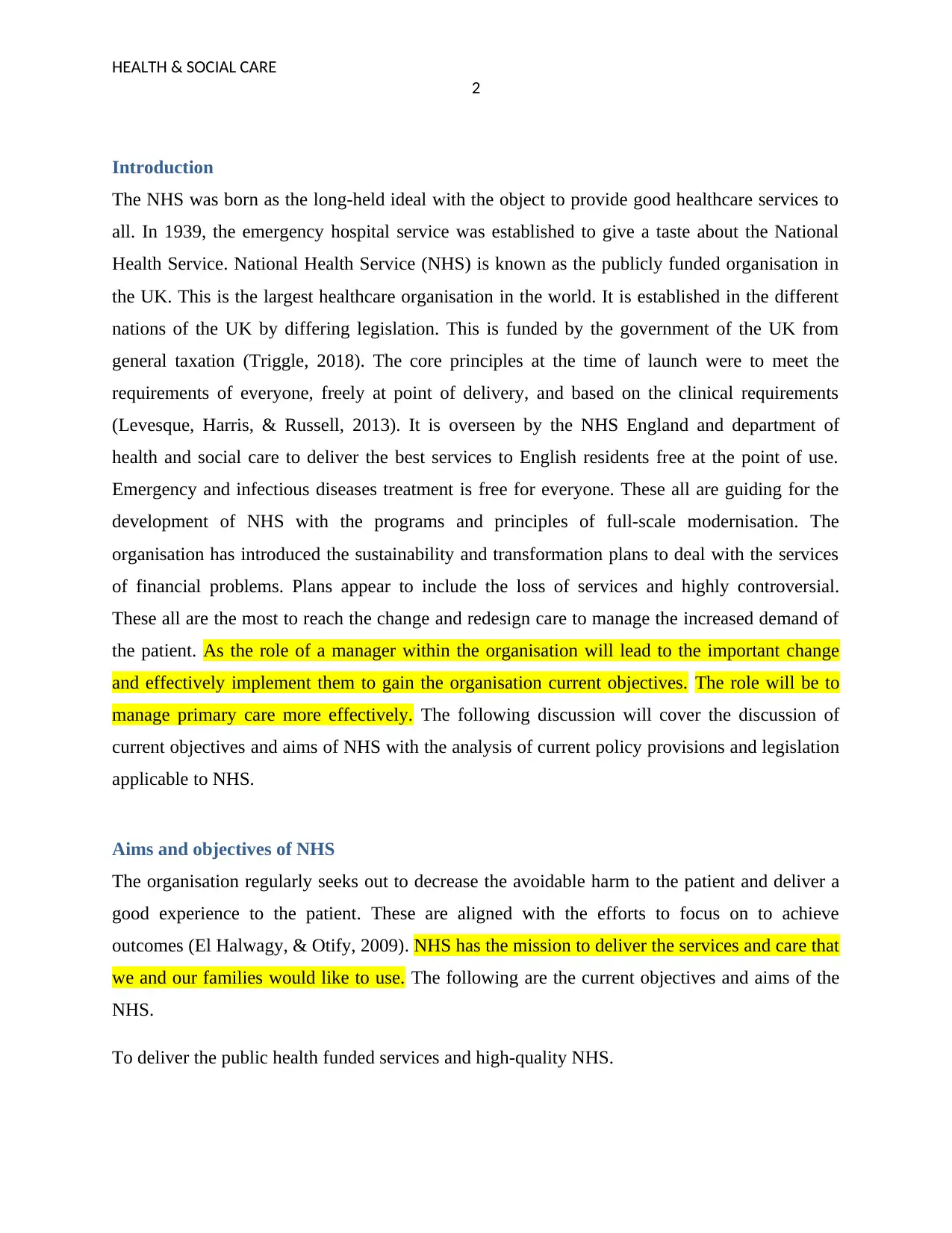
HEALTH & SOCIAL CARE
2
Introduction
The NHS was born as the long-held ideal with the object to provide good healthcare services to
all. In 1939, the emergency hospital service was established to give a taste about the National
Health Service. National Health Service (NHS) is known as the publicly funded organisation in
the UK. This is the largest healthcare organisation in the world. It is established in the different
nations of the UK by differing legislation. This is funded by the government of the UK from
general taxation (Triggle, 2018). The core principles at the time of launch were to meet the
requirements of everyone, freely at point of delivery, and based on the clinical requirements
(Levesque, Harris, & Russell, 2013). It is overseen by the NHS England and department of
health and social care to deliver the best services to English residents free at the point of use.
Emergency and infectious diseases treatment is free for everyone. These all are guiding for the
development of NHS with the programs and principles of full-scale modernisation. The
organisation has introduced the sustainability and transformation plans to deal with the services
of financial problems. Plans appear to include the loss of services and highly controversial.
These all are the most to reach the change and redesign care to manage the increased demand of
the patient. As the role of a manager within the organisation will lead to the important change
and effectively implement them to gain the organisation current objectives. The role will be to
manage primary care more effectively. The following discussion will cover the discussion of
current objectives and aims of NHS with the analysis of current policy provisions and legislation
applicable to NHS.
Aims and objectives of NHS
The organisation regularly seeks out to decrease the avoidable harm to the patient and deliver a
good experience to the patient. These are aligned with the efforts to focus on to achieve
outcomes (El Halwagy, & Otify, 2009). NHS has the mission to deliver the services and care that
we and our families would like to use. The following are the current objectives and aims of the
NHS.
To deliver the public health funded services and high-quality NHS.
2
Introduction
The NHS was born as the long-held ideal with the object to provide good healthcare services to
all. In 1939, the emergency hospital service was established to give a taste about the National
Health Service. National Health Service (NHS) is known as the publicly funded organisation in
the UK. This is the largest healthcare organisation in the world. It is established in the different
nations of the UK by differing legislation. This is funded by the government of the UK from
general taxation (Triggle, 2018). The core principles at the time of launch were to meet the
requirements of everyone, freely at point of delivery, and based on the clinical requirements
(Levesque, Harris, & Russell, 2013). It is overseen by the NHS England and department of
health and social care to deliver the best services to English residents free at the point of use.
Emergency and infectious diseases treatment is free for everyone. These all are guiding for the
development of NHS with the programs and principles of full-scale modernisation. The
organisation has introduced the sustainability and transformation plans to deal with the services
of financial problems. Plans appear to include the loss of services and highly controversial.
These all are the most to reach the change and redesign care to manage the increased demand of
the patient. As the role of a manager within the organisation will lead to the important change
and effectively implement them to gain the organisation current objectives. The role will be to
manage primary care more effectively. The following discussion will cover the discussion of
current objectives and aims of NHS with the analysis of current policy provisions and legislation
applicable to NHS.
Aims and objectives of NHS
The organisation regularly seeks out to decrease the avoidable harm to the patient and deliver a
good experience to the patient. These are aligned with the efforts to focus on to achieve
outcomes (El Halwagy, & Otify, 2009). NHS has the mission to deliver the services and care that
we and our families would like to use. The following are the current objectives and aims of the
NHS.
To deliver the public health funded services and high-quality NHS.
⊘ This is a preview!⊘
Do you want full access?
Subscribe today to unlock all pages.

Trusted by 1+ million students worldwide
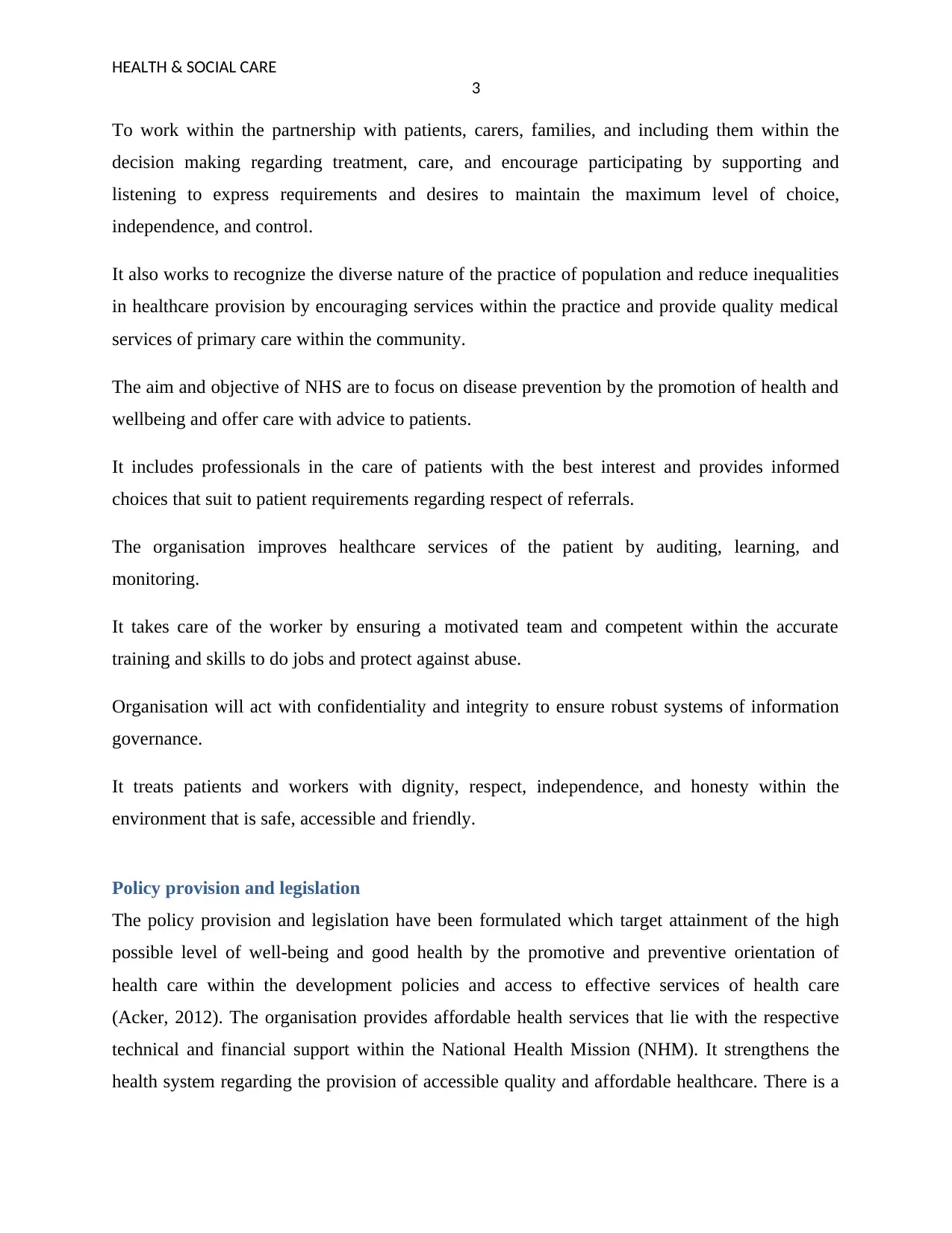
HEALTH & SOCIAL CARE
3
To work within the partnership with patients, carers, families, and including them within the
decision making regarding treatment, care, and encourage participating by supporting and
listening to express requirements and desires to maintain the maximum level of choice,
independence, and control.
It also works to recognize the diverse nature of the practice of population and reduce inequalities
in healthcare provision by encouraging services within the practice and provide quality medical
services of primary care within the community.
The aim and objective of NHS are to focus on disease prevention by the promotion of health and
wellbeing and offer care with advice to patients.
It includes professionals in the care of patients with the best interest and provides informed
choices that suit to patient requirements regarding respect of referrals.
The organisation improves healthcare services of the patient by auditing, learning, and
monitoring.
It takes care of the worker by ensuring a motivated team and competent within the accurate
training and skills to do jobs and protect against abuse.
Organisation will act with confidentiality and integrity to ensure robust systems of information
governance.
It treats patients and workers with dignity, respect, independence, and honesty within the
environment that is safe, accessible and friendly.
Policy provision and legislation
The policy provision and legislation have been formulated which target attainment of the high
possible level of well-being and good health by the promotive and preventive orientation of
health care within the development policies and access to effective services of health care
(Acker, 2012). The organisation provides affordable health services that lie with the respective
technical and financial support within the National Health Mission (NHM). It strengthens the
health system regarding the provision of accessible quality and affordable healthcare. There is a
3
To work within the partnership with patients, carers, families, and including them within the
decision making regarding treatment, care, and encourage participating by supporting and
listening to express requirements and desires to maintain the maximum level of choice,
independence, and control.
It also works to recognize the diverse nature of the practice of population and reduce inequalities
in healthcare provision by encouraging services within the practice and provide quality medical
services of primary care within the community.
The aim and objective of NHS are to focus on disease prevention by the promotion of health and
wellbeing and offer care with advice to patients.
It includes professionals in the care of patients with the best interest and provides informed
choices that suit to patient requirements regarding respect of referrals.
The organisation improves healthcare services of the patient by auditing, learning, and
monitoring.
It takes care of the worker by ensuring a motivated team and competent within the accurate
training and skills to do jobs and protect against abuse.
Organisation will act with confidentiality and integrity to ensure robust systems of information
governance.
It treats patients and workers with dignity, respect, independence, and honesty within the
environment that is safe, accessible and friendly.
Policy provision and legislation
The policy provision and legislation have been formulated which target attainment of the high
possible level of well-being and good health by the promotive and preventive orientation of
health care within the development policies and access to effective services of health care
(Acker, 2012). The organisation provides affordable health services that lie with the respective
technical and financial support within the National Health Mission (NHM). It strengthens the
health system regarding the provision of accessible quality and affordable healthcare. There is a
Paraphrase This Document
Need a fresh take? Get an instant paraphrase of this document with our AI Paraphraser
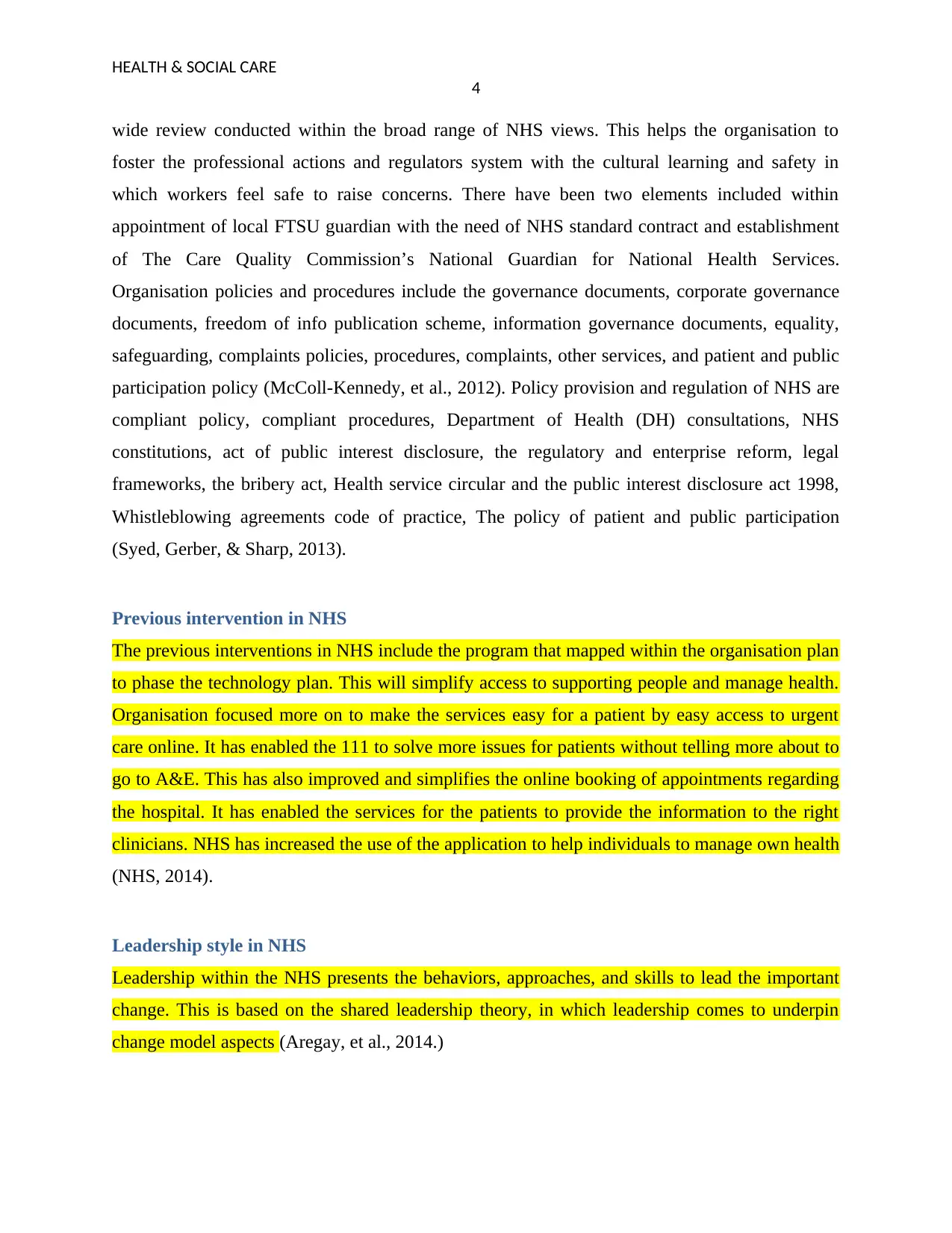
HEALTH & SOCIAL CARE
4
wide review conducted within the broad range of NHS views. This helps the organisation to
foster the professional actions and regulators system with the cultural learning and safety in
which workers feel safe to raise concerns. There have been two elements included within
appointment of local FTSU guardian with the need of NHS standard contract and establishment
of The Care Quality Commission’s National Guardian for National Health Services.
Organisation policies and procedures include the governance documents, corporate governance
documents, freedom of info publication scheme, information governance documents, equality,
safeguarding, complaints policies, procedures, complaints, other services, and patient and public
participation policy (McColl-Kennedy, et al., 2012). Policy provision and regulation of NHS are
compliant policy, compliant procedures, Department of Health (DH) consultations, NHS
constitutions, act of public interest disclosure, the regulatory and enterprise reform, legal
frameworks, the bribery act, Health service circular and the public interest disclosure act 1998,
Whistleblowing agreements code of practice, The policy of patient and public participation
(Syed, Gerber, & Sharp, 2013).
Previous intervention in NHS
The previous interventions in NHS include the program that mapped within the organisation plan
to phase the technology plan. This will simplify access to supporting people and manage health.
Organisation focused more on to make the services easy for a patient by easy access to urgent
care online. It has enabled the 111 to solve more issues for patients without telling more about to
go to A&E. This has also improved and simplifies the online booking of appointments regarding
the hospital. It has enabled the services for the patients to provide the information to the right
clinicians. NHS has increased the use of the application to help individuals to manage own health
(NHS, 2014).
Leadership style in NHS
Leadership within the NHS presents the behaviors, approaches, and skills to lead the important
change. This is based on the shared leadership theory, in which leadership comes to underpin
change model aspects (Aregay, et al., 2014.)
4
wide review conducted within the broad range of NHS views. This helps the organisation to
foster the professional actions and regulators system with the cultural learning and safety in
which workers feel safe to raise concerns. There have been two elements included within
appointment of local FTSU guardian with the need of NHS standard contract and establishment
of The Care Quality Commission’s National Guardian for National Health Services.
Organisation policies and procedures include the governance documents, corporate governance
documents, freedom of info publication scheme, information governance documents, equality,
safeguarding, complaints policies, procedures, complaints, other services, and patient and public
participation policy (McColl-Kennedy, et al., 2012). Policy provision and regulation of NHS are
compliant policy, compliant procedures, Department of Health (DH) consultations, NHS
constitutions, act of public interest disclosure, the regulatory and enterprise reform, legal
frameworks, the bribery act, Health service circular and the public interest disclosure act 1998,
Whistleblowing agreements code of practice, The policy of patient and public participation
(Syed, Gerber, & Sharp, 2013).
Previous intervention in NHS
The previous interventions in NHS include the program that mapped within the organisation plan
to phase the technology plan. This will simplify access to supporting people and manage health.
Organisation focused more on to make the services easy for a patient by easy access to urgent
care online. It has enabled the 111 to solve more issues for patients without telling more about to
go to A&E. This has also improved and simplifies the online booking of appointments regarding
the hospital. It has enabled the services for the patients to provide the information to the right
clinicians. NHS has increased the use of the application to help individuals to manage own health
(NHS, 2014).
Leadership style in NHS
Leadership within the NHS presents the behaviors, approaches, and skills to lead the important
change. This is based on the shared leadership theory, in which leadership comes to underpin
change model aspects (Aregay, et al., 2014.)
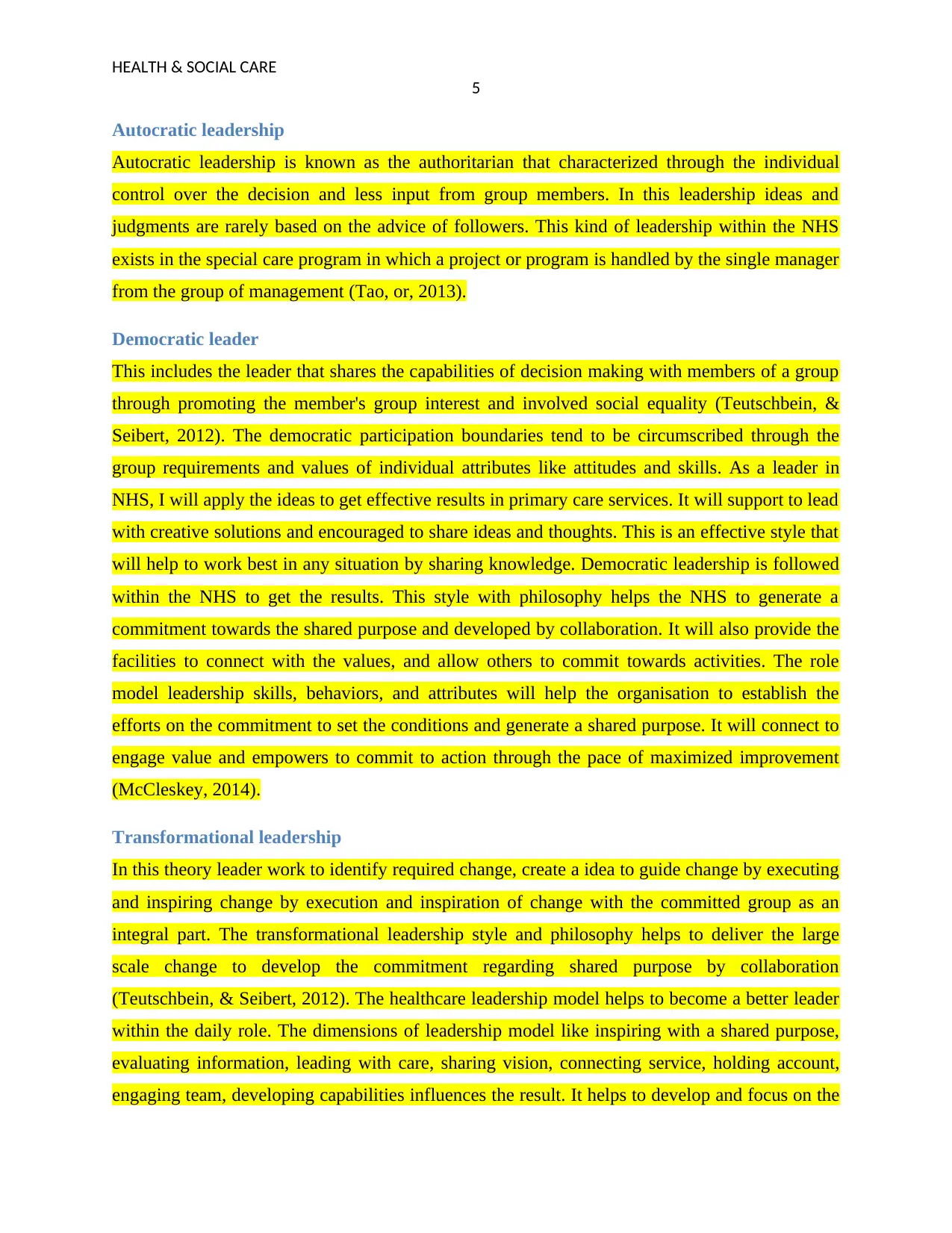
HEALTH & SOCIAL CARE
5
Autocratic leadership
Autocratic leadership is known as the authoritarian that characterized through the individual
control over the decision and less input from group members. In this leadership ideas and
judgments are rarely based on the advice of followers. This kind of leadership within the NHS
exists in the special care program in which a project or program is handled by the single manager
from the group of management (Tao, or, 2013).
Democratic leader
This includes the leader that shares the capabilities of decision making with members of a group
through promoting the member's group interest and involved social equality (Teutschbein, &
Seibert, 2012). The democratic participation boundaries tend to be circumscribed through the
group requirements and values of individual attributes like attitudes and skills. As a leader in
NHS, I will apply the ideas to get effective results in primary care services. It will support to lead
with creative solutions and encouraged to share ideas and thoughts. This is an effective style that
will help to work best in any situation by sharing knowledge. Democratic leadership is followed
within the NHS to get the results. This style with philosophy helps the NHS to generate a
commitment towards the shared purpose and developed by collaboration. It will also provide the
facilities to connect with the values, and allow others to commit towards activities. The role
model leadership skills, behaviors, and attributes will help the organisation to establish the
efforts on the commitment to set the conditions and generate a shared purpose. It will connect to
engage value and empowers to commit to action through the pace of maximized improvement
(McCleskey, 2014).
Transformational leadership
In this theory leader work to identify required change, create a idea to guide change by executing
and inspiring change by execution and inspiration of change with the committed group as an
integral part. The transformational leadership style and philosophy helps to deliver the large
scale change to develop the commitment regarding shared purpose by collaboration
(Teutschbein, & Seibert, 2012). The healthcare leadership model helps to become a better leader
within the daily role. The dimensions of leadership model like inspiring with a shared purpose,
evaluating information, leading with care, sharing vision, connecting service, holding account,
engaging team, developing capabilities influences the result. It helps to develop and focus on the
5
Autocratic leadership
Autocratic leadership is known as the authoritarian that characterized through the individual
control over the decision and less input from group members. In this leadership ideas and
judgments are rarely based on the advice of followers. This kind of leadership within the NHS
exists in the special care program in which a project or program is handled by the single manager
from the group of management (Tao, or, 2013).
Democratic leader
This includes the leader that shares the capabilities of decision making with members of a group
through promoting the member's group interest and involved social equality (Teutschbein, &
Seibert, 2012). The democratic participation boundaries tend to be circumscribed through the
group requirements and values of individual attributes like attitudes and skills. As a leader in
NHS, I will apply the ideas to get effective results in primary care services. It will support to lead
with creative solutions and encouraged to share ideas and thoughts. This is an effective style that
will help to work best in any situation by sharing knowledge. Democratic leadership is followed
within the NHS to get the results. This style with philosophy helps the NHS to generate a
commitment towards the shared purpose and developed by collaboration. It will also provide the
facilities to connect with the values, and allow others to commit towards activities. The role
model leadership skills, behaviors, and attributes will help the organisation to establish the
efforts on the commitment to set the conditions and generate a shared purpose. It will connect to
engage value and empowers to commit to action through the pace of maximized improvement
(McCleskey, 2014).
Transformational leadership
In this theory leader work to identify required change, create a idea to guide change by executing
and inspiring change by execution and inspiration of change with the committed group as an
integral part. The transformational leadership style and philosophy helps to deliver the large
scale change to develop the commitment regarding shared purpose by collaboration
(Teutschbein, & Seibert, 2012). The healthcare leadership model helps to become a better leader
within the daily role. The dimensions of leadership model like inspiring with a shared purpose,
evaluating information, leading with care, sharing vision, connecting service, holding account,
engaging team, developing capabilities influences the result. It helps to develop and focus on the
⊘ This is a preview!⊘
Do you want full access?
Subscribe today to unlock all pages.

Trusted by 1+ million students worldwide
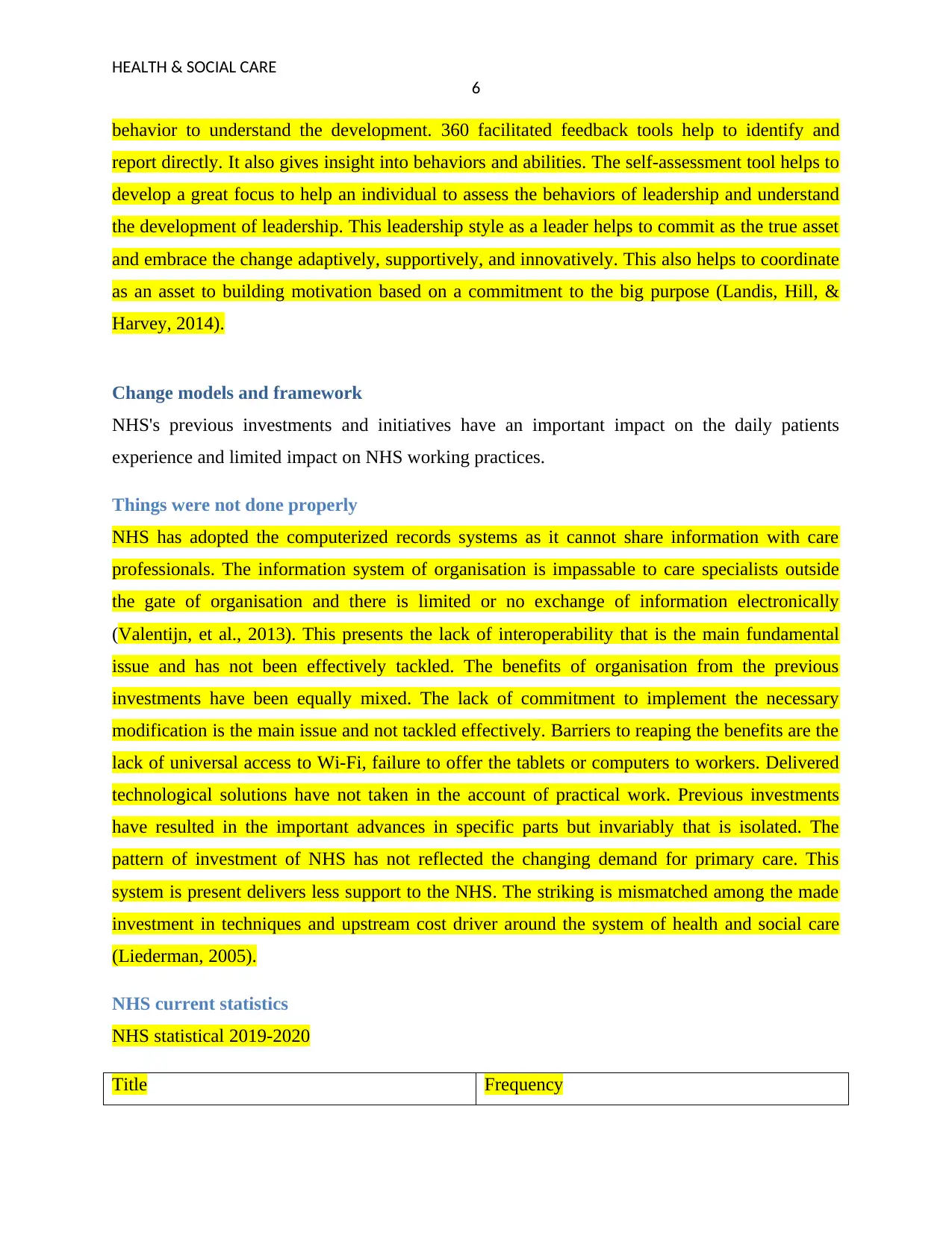
HEALTH & SOCIAL CARE
6
behavior to understand the development. 360 facilitated feedback tools help to identify and
report directly. It also gives insight into behaviors and abilities. The self-assessment tool helps to
develop a great focus to help an individual to assess the behaviors of leadership and understand
the development of leadership. This leadership style as a leader helps to commit as the true asset
and embrace the change adaptively, supportively, and innovatively. This also helps to coordinate
as an asset to building motivation based on a commitment to the big purpose (Landis, Hill, &
Harvey, 2014).
Change models and framework
NHS's previous investments and initiatives have an important impact on the daily patients
experience and limited impact on NHS working practices.
Things were not done properly
NHS has adopted the computerized records systems as it cannot share information with care
professionals. The information system of organisation is impassable to care specialists outside
the gate of organisation and there is limited or no exchange of information electronically
(Valentijn, et al., 2013). This presents the lack of interoperability that is the main fundamental
issue and has not been effectively tackled. The benefits of organisation from the previous
investments have been equally mixed. The lack of commitment to implement the necessary
modification is the main issue and not tackled effectively. Barriers to reaping the benefits are the
lack of universal access to Wi-Fi, failure to offer the tablets or computers to workers. Delivered
technological solutions have not taken in the account of practical work. Previous investments
have resulted in the important advances in specific parts but invariably that is isolated. The
pattern of investment of NHS has not reflected the changing demand for primary care. This
system is present delivers less support to the NHS. The striking is mismatched among the made
investment in techniques and upstream cost driver around the system of health and social care
(Liederman, 2005).
NHS current statistics
NHS statistical 2019-2020
Title Frequency
6
behavior to understand the development. 360 facilitated feedback tools help to identify and
report directly. It also gives insight into behaviors and abilities. The self-assessment tool helps to
develop a great focus to help an individual to assess the behaviors of leadership and understand
the development of leadership. This leadership style as a leader helps to commit as the true asset
and embrace the change adaptively, supportively, and innovatively. This also helps to coordinate
as an asset to building motivation based on a commitment to the big purpose (Landis, Hill, &
Harvey, 2014).
Change models and framework
NHS's previous investments and initiatives have an important impact on the daily patients
experience and limited impact on NHS working practices.
Things were not done properly
NHS has adopted the computerized records systems as it cannot share information with care
professionals. The information system of organisation is impassable to care specialists outside
the gate of organisation and there is limited or no exchange of information electronically
(Valentijn, et al., 2013). This presents the lack of interoperability that is the main fundamental
issue and has not been effectively tackled. The benefits of organisation from the previous
investments have been equally mixed. The lack of commitment to implement the necessary
modification is the main issue and not tackled effectively. Barriers to reaping the benefits are the
lack of universal access to Wi-Fi, failure to offer the tablets or computers to workers. Delivered
technological solutions have not taken in the account of practical work. Previous investments
have resulted in the important advances in specific parts but invariably that is isolated. The
pattern of investment of NHS has not reflected the changing demand for primary care. This
system is present delivers less support to the NHS. The striking is mismatched among the made
investment in techniques and upstream cost driver around the system of health and social care
(Liederman, 2005).
NHS current statistics
NHS statistical 2019-2020
Title Frequency
Paraphrase This Document
Need a fresh take? Get an instant paraphrase of this document with our AI Paraphraser
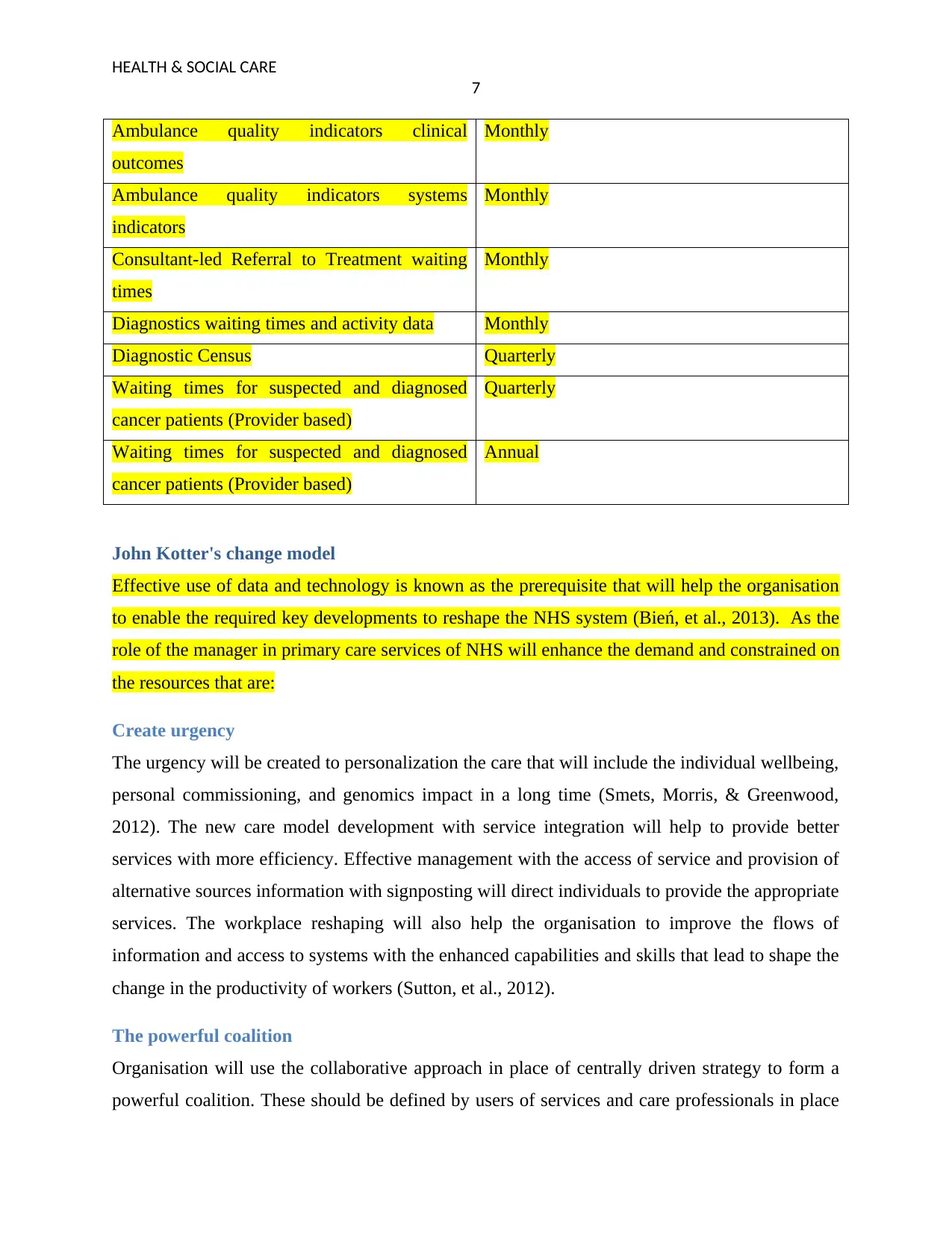
HEALTH & SOCIAL CARE
7
Ambulance quality indicators clinical
outcomes
Monthly
Ambulance quality indicators systems
indicators
Monthly
Consultant-led Referral to Treatment waiting
times
Monthly
Diagnostics waiting times and activity data Monthly
Diagnostic Census Quarterly
Waiting times for suspected and diagnosed
cancer patients (Provider based)
Quarterly
Waiting times for suspected and diagnosed
cancer patients (Provider based)
Annual
John Kotter's change model
Effective use of data and technology is known as the prerequisite that will help the organisation
to enable the required key developments to reshape the NHS system (Bień, et al., 2013). As the
role of the manager in primary care services of NHS will enhance the demand and constrained on
the resources that are:
Create urgency
The urgency will be created to personalization the care that will include the individual wellbeing,
personal commissioning, and genomics impact in a long time (Smets, Morris, & Greenwood,
2012). The new care model development with service integration will help to provide better
services with more efficiency. Effective management with the access of service and provision of
alternative sources information with signposting will direct individuals to provide the appropriate
services. The workplace reshaping will also help the organisation to improve the flows of
information and access to systems with the enhanced capabilities and skills that lead to shape the
change in the productivity of workers (Sutton, et al., 2012).
The powerful coalition
Organisation will use the collaborative approach in place of centrally driven strategy to form a
powerful coalition. These should be defined by users of services and care professionals in place
7
Ambulance quality indicators clinical
outcomes
Monthly
Ambulance quality indicators systems
indicators
Monthly
Consultant-led Referral to Treatment waiting
times
Monthly
Diagnostics waiting times and activity data Monthly
Diagnostic Census Quarterly
Waiting times for suspected and diagnosed
cancer patients (Provider based)
Quarterly
Waiting times for suspected and diagnosed
cancer patients (Provider based)
Annual
John Kotter's change model
Effective use of data and technology is known as the prerequisite that will help the organisation
to enable the required key developments to reshape the NHS system (Bień, et al., 2013). As the
role of the manager in primary care services of NHS will enhance the demand and constrained on
the resources that are:
Create urgency
The urgency will be created to personalization the care that will include the individual wellbeing,
personal commissioning, and genomics impact in a long time (Smets, Morris, & Greenwood,
2012). The new care model development with service integration will help to provide better
services with more efficiency. Effective management with the access of service and provision of
alternative sources information with signposting will direct individuals to provide the appropriate
services. The workplace reshaping will also help the organisation to improve the flows of
information and access to systems with the enhanced capabilities and skills that lead to shape the
change in the productivity of workers (Sutton, et al., 2012).
The powerful coalition
Organisation will use the collaborative approach in place of centrally driven strategy to form a
powerful coalition. These should be defined by users of services and care professionals in place
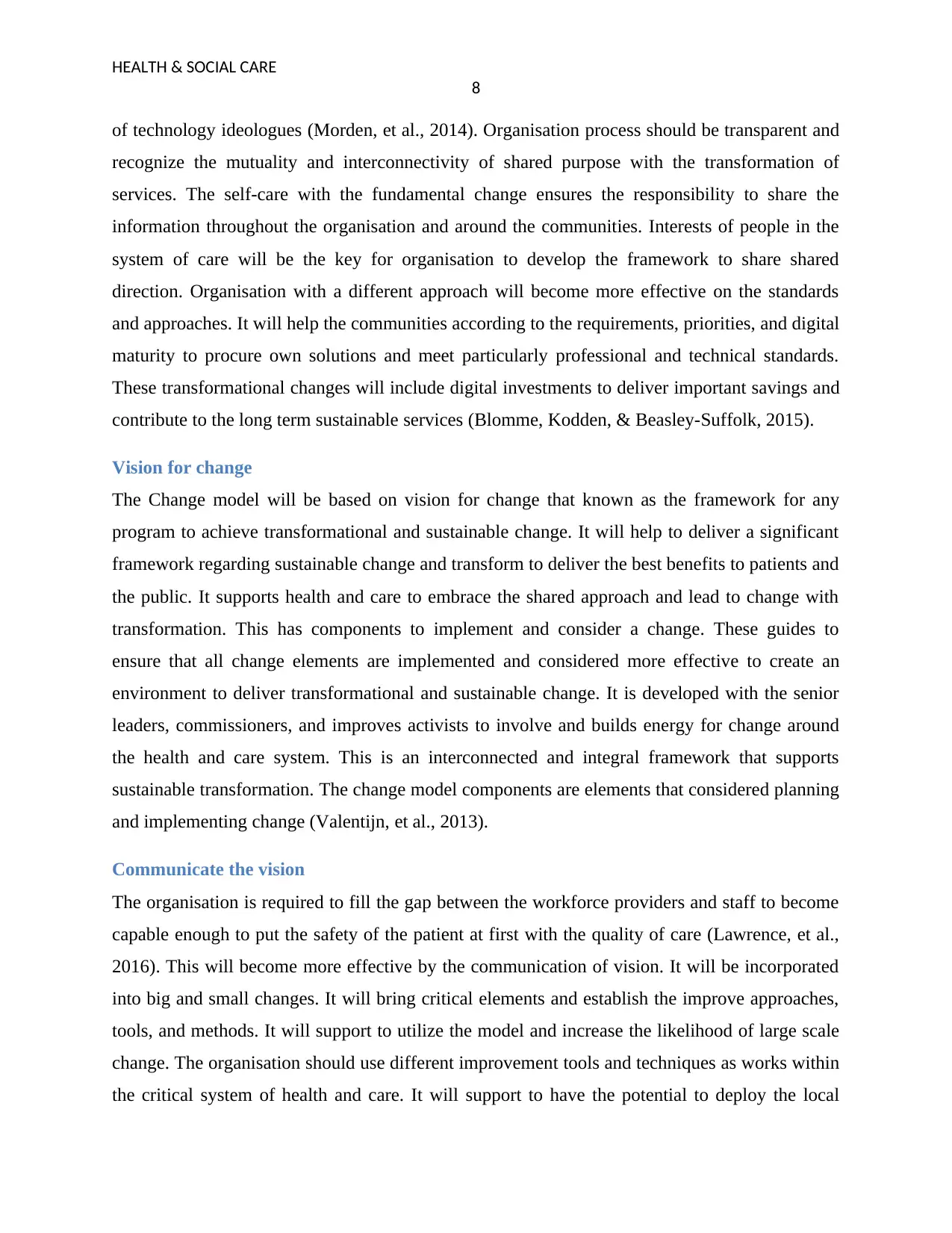
HEALTH & SOCIAL CARE
8
of technology ideologues (Morden, et al., 2014). Organisation process should be transparent and
recognize the mutuality and interconnectivity of shared purpose with the transformation of
services. The self-care with the fundamental change ensures the responsibility to share the
information throughout the organisation and around the communities. Interests of people in the
system of care will be the key for organisation to develop the framework to share shared
direction. Organisation with a different approach will become more effective on the standards
and approaches. It will help the communities according to the requirements, priorities, and digital
maturity to procure own solutions and meet particularly professional and technical standards.
These transformational changes will include digital investments to deliver important savings and
contribute to the long term sustainable services (Blomme, Kodden, & Beasley-Suffolk, 2015).
Vision for change
The Change model will be based on vision for change that known as the framework for any
program to achieve transformational and sustainable change. It will help to deliver a significant
framework regarding sustainable change and transform to deliver the best benefits to patients and
the public. It supports health and care to embrace the shared approach and lead to change with
transformation. This has components to implement and consider a change. These guides to
ensure that all change elements are implemented and considered more effective to create an
environment to deliver transformational and sustainable change. It is developed with the senior
leaders, commissioners, and improves activists to involve and builds energy for change around
the health and care system. This is an interconnected and integral framework that supports
sustainable transformation. The change model components are elements that considered planning
and implementing change (Valentijn, et al., 2013).
Communicate the vision
The organisation is required to fill the gap between the workforce providers and staff to become
capable enough to put the safety of the patient at first with the quality of care (Lawrence, et al.,
2016). This will become more effective by the communication of vision. It will be incorporated
into big and small changes. It will bring critical elements and establish the improve approaches,
tools, and methods. It will support to utilize the model and increase the likelihood of large scale
change. The organisation should use different improvement tools and techniques as works within
the critical system of health and care. It will support to have the potential to deploy the local
8
of technology ideologues (Morden, et al., 2014). Organisation process should be transparent and
recognize the mutuality and interconnectivity of shared purpose with the transformation of
services. The self-care with the fundamental change ensures the responsibility to share the
information throughout the organisation and around the communities. Interests of people in the
system of care will be the key for organisation to develop the framework to share shared
direction. Organisation with a different approach will become more effective on the standards
and approaches. It will help the communities according to the requirements, priorities, and digital
maturity to procure own solutions and meet particularly professional and technical standards.
These transformational changes will include digital investments to deliver important savings and
contribute to the long term sustainable services (Blomme, Kodden, & Beasley-Suffolk, 2015).
Vision for change
The Change model will be based on vision for change that known as the framework for any
program to achieve transformational and sustainable change. It will help to deliver a significant
framework regarding sustainable change and transform to deliver the best benefits to patients and
the public. It supports health and care to embrace the shared approach and lead to change with
transformation. This has components to implement and consider a change. These guides to
ensure that all change elements are implemented and considered more effective to create an
environment to deliver transformational and sustainable change. It is developed with the senior
leaders, commissioners, and improves activists to involve and builds energy for change around
the health and care system. This is an interconnected and integral framework that supports
sustainable transformation. The change model components are elements that considered planning
and implementing change (Valentijn, et al., 2013).
Communicate the vision
The organisation is required to fill the gap between the workforce providers and staff to become
capable enough to put the safety of the patient at first with the quality of care (Lawrence, et al.,
2016). This will become more effective by the communication of vision. It will be incorporated
into big and small changes. It will bring critical elements and establish the improve approaches,
tools, and methods. It will support to utilize the model and increase the likelihood of large scale
change. The organisation should use different improvement tools and techniques as works within
the critical system of health and care. It will support to have the potential to deploy the local
⊘ This is a preview!⊘
Do you want full access?
Subscribe today to unlock all pages.

Trusted by 1+ million students worldwide
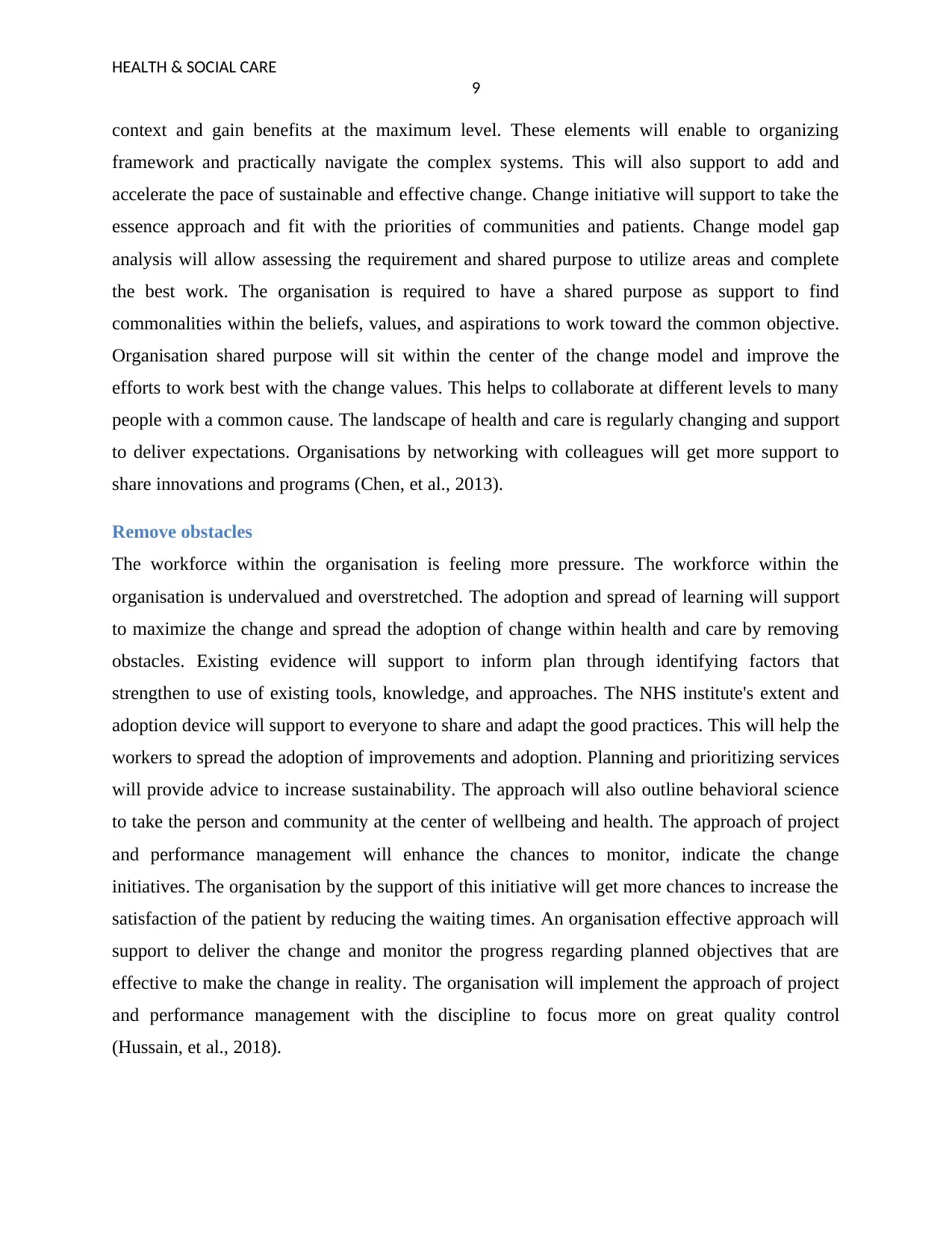
HEALTH & SOCIAL CARE
9
context and gain benefits at the maximum level. These elements will enable to organizing
framework and practically navigate the complex systems. This will also support to add and
accelerate the pace of sustainable and effective change. Change initiative will support to take the
essence approach and fit with the priorities of communities and patients. Change model gap
analysis will allow assessing the requirement and shared purpose to utilize areas and complete
the best work. The organisation is required to have a shared purpose as support to find
commonalities within the beliefs, values, and aspirations to work toward the common objective.
Organisation shared purpose will sit within the center of the change model and improve the
efforts to work best with the change values. This helps to collaborate at different levels to many
people with a common cause. The landscape of health and care is regularly changing and support
to deliver expectations. Organisations by networking with colleagues will get more support to
share innovations and programs (Chen, et al., 2013).
Remove obstacles
The workforce within the organisation is feeling more pressure. The workforce within the
organisation is undervalued and overstretched. The adoption and spread of learning will support
to maximize the change and spread the adoption of change within health and care by removing
obstacles. Existing evidence will support to inform plan through identifying factors that
strengthen to use of existing tools, knowledge, and approaches. The NHS institute's extent and
adoption device will support to everyone to share and adapt the good practices. This will help the
workers to spread the adoption of improvements and adoption. Planning and prioritizing services
will provide advice to increase sustainability. The approach will also outline behavioral science
to take the person and community at the center of wellbeing and health. The approach of project
and performance management will enhance the chances to monitor, indicate the change
initiatives. The organisation by the support of this initiative will get more chances to increase the
satisfaction of the patient by reducing the waiting times. An organisation effective approach will
support to deliver the change and monitor the progress regarding planned objectives that are
effective to make the change in reality. The organisation will implement the approach of project
and performance management with the discipline to focus more on great quality control
(Hussain, et al., 2018).
9
context and gain benefits at the maximum level. These elements will enable to organizing
framework and practically navigate the complex systems. This will also support to add and
accelerate the pace of sustainable and effective change. Change initiative will support to take the
essence approach and fit with the priorities of communities and patients. Change model gap
analysis will allow assessing the requirement and shared purpose to utilize areas and complete
the best work. The organisation is required to have a shared purpose as support to find
commonalities within the beliefs, values, and aspirations to work toward the common objective.
Organisation shared purpose will sit within the center of the change model and improve the
efforts to work best with the change values. This helps to collaborate at different levels to many
people with a common cause. The landscape of health and care is regularly changing and support
to deliver expectations. Organisations by networking with colleagues will get more support to
share innovations and programs (Chen, et al., 2013).
Remove obstacles
The workforce within the organisation is feeling more pressure. The workforce within the
organisation is undervalued and overstretched. The adoption and spread of learning will support
to maximize the change and spread the adoption of change within health and care by removing
obstacles. Existing evidence will support to inform plan through identifying factors that
strengthen to use of existing tools, knowledge, and approaches. The NHS institute's extent and
adoption device will support to everyone to share and adapt the good practices. This will help the
workers to spread the adoption of improvements and adoption. Planning and prioritizing services
will provide advice to increase sustainability. The approach will also outline behavioral science
to take the person and community at the center of wellbeing and health. The approach of project
and performance management will enhance the chances to monitor, indicate the change
initiatives. The organisation by the support of this initiative will get more chances to increase the
satisfaction of the patient by reducing the waiting times. An organisation effective approach will
support to deliver the change and monitor the progress regarding planned objectives that are
effective to make the change in reality. The organisation will implement the approach of project
and performance management with the discipline to focus more on great quality control
(Hussain, et al., 2018).
Paraphrase This Document
Need a fresh take? Get an instant paraphrase of this document with our AI Paraphraser
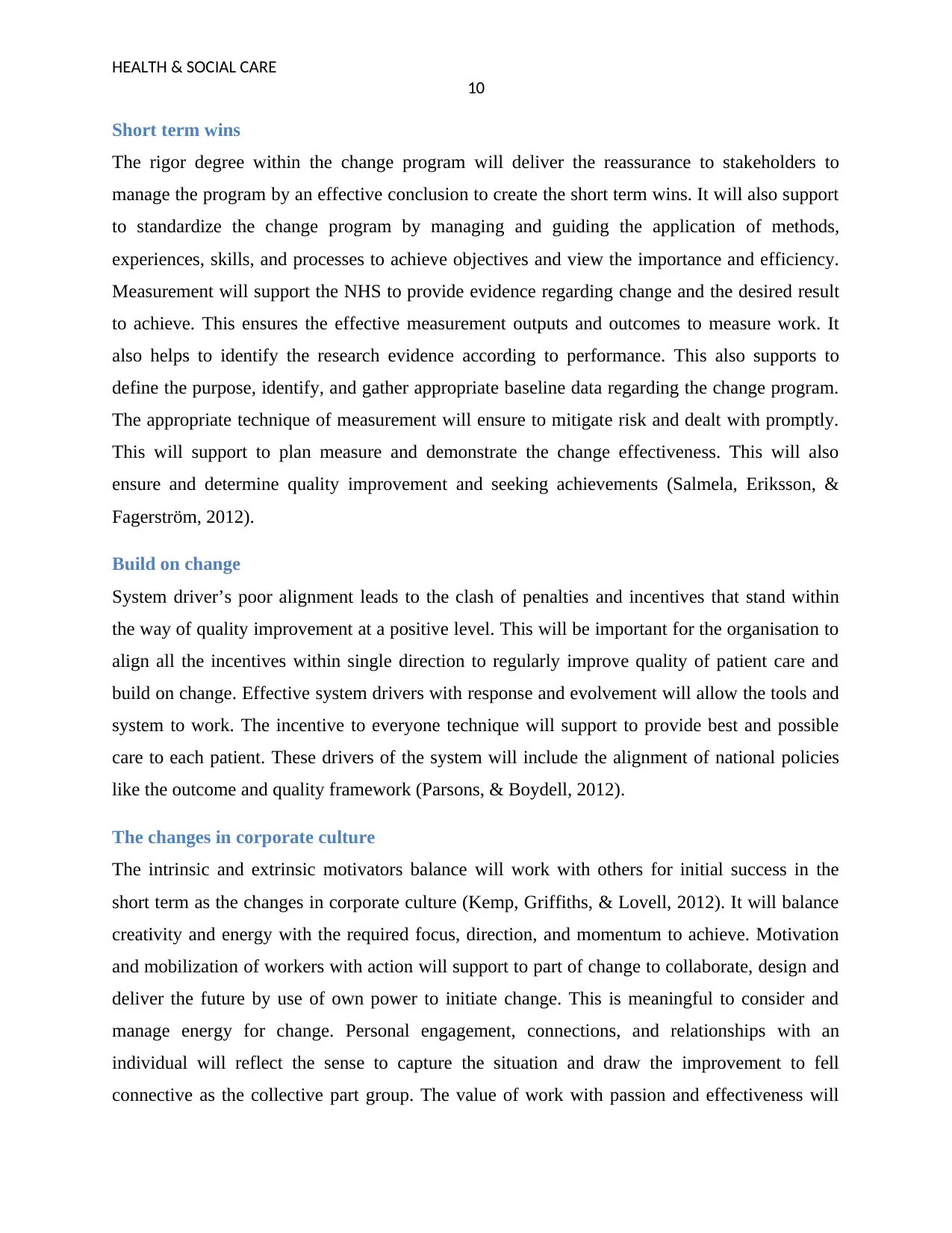
HEALTH & SOCIAL CARE
10
Short term wins
The rigor degree within the change program will deliver the reassurance to stakeholders to
manage the program by an effective conclusion to create the short term wins. It will also support
to standardize the change program by managing and guiding the application of methods,
experiences, skills, and processes to achieve objectives and view the importance and efficiency.
Measurement will support the NHS to provide evidence regarding change and the desired result
to achieve. This ensures the effective measurement outputs and outcomes to measure work. It
also helps to identify the research evidence according to performance. This also supports to
define the purpose, identify, and gather appropriate baseline data regarding the change program.
The appropriate technique of measurement will ensure to mitigate risk and dealt with promptly.
This will support to plan measure and demonstrate the change effectiveness. This will also
ensure and determine quality improvement and seeking achievements (Salmela, Eriksson, &
Fagerström, 2012).
Build on change
System driver’s poor alignment leads to the clash of penalties and incentives that stand within
the way of quality improvement at a positive level. This will be important for the organisation to
align all the incentives within single direction to regularly improve quality of patient care and
build on change. Effective system drivers with response and evolvement will allow the tools and
system to work. The incentive to everyone technique will support to provide best and possible
care to each patient. These drivers of the system will include the alignment of national policies
like the outcome and quality framework (Parsons, & Boydell, 2012).
The changes in corporate culture
The intrinsic and extrinsic motivators balance will work with others for initial success in the
short term as the changes in corporate culture (Kemp, Griffiths, & Lovell, 2012). It will balance
creativity and energy with the required focus, direction, and momentum to achieve. Motivation
and mobilization of workers with action will support to part of change to collaborate, design and
deliver the future by use of own power to initiate change. This is meaningful to consider and
manage energy for change. Personal engagement, connections, and relationships with an
individual will reflect the sense to capture the situation and draw the improvement to fell
connective as the collective part group. The value of work with passion and effectiveness will
10
Short term wins
The rigor degree within the change program will deliver the reassurance to stakeholders to
manage the program by an effective conclusion to create the short term wins. It will also support
to standardize the change program by managing and guiding the application of methods,
experiences, skills, and processes to achieve objectives and view the importance and efficiency.
Measurement will support the NHS to provide evidence regarding change and the desired result
to achieve. This ensures the effective measurement outputs and outcomes to measure work. It
also helps to identify the research evidence according to performance. This also supports to
define the purpose, identify, and gather appropriate baseline data regarding the change program.
The appropriate technique of measurement will ensure to mitigate risk and dealt with promptly.
This will support to plan measure and demonstrate the change effectiveness. This will also
ensure and determine quality improvement and seeking achievements (Salmela, Eriksson, &
Fagerström, 2012).
Build on change
System driver’s poor alignment leads to the clash of penalties and incentives that stand within
the way of quality improvement at a positive level. This will be important for the organisation to
align all the incentives within single direction to regularly improve quality of patient care and
build on change. Effective system drivers with response and evolvement will allow the tools and
system to work. The incentive to everyone technique will support to provide best and possible
care to each patient. These drivers of the system will include the alignment of national policies
like the outcome and quality framework (Parsons, & Boydell, 2012).
The changes in corporate culture
The intrinsic and extrinsic motivators balance will work with others for initial success in the
short term as the changes in corporate culture (Kemp, Griffiths, & Lovell, 2012). It will balance
creativity and energy with the required focus, direction, and momentum to achieve. Motivation
and mobilization of workers with action will support to part of change to collaborate, design and
deliver the future by use of own power to initiate change. This is meaningful to consider and
manage energy for change. Personal engagement, connections, and relationships with an
individual will reflect the sense to capture the situation and draw the improvement to fell
connective as the collective part group. The value of work with passion and effectiveness will
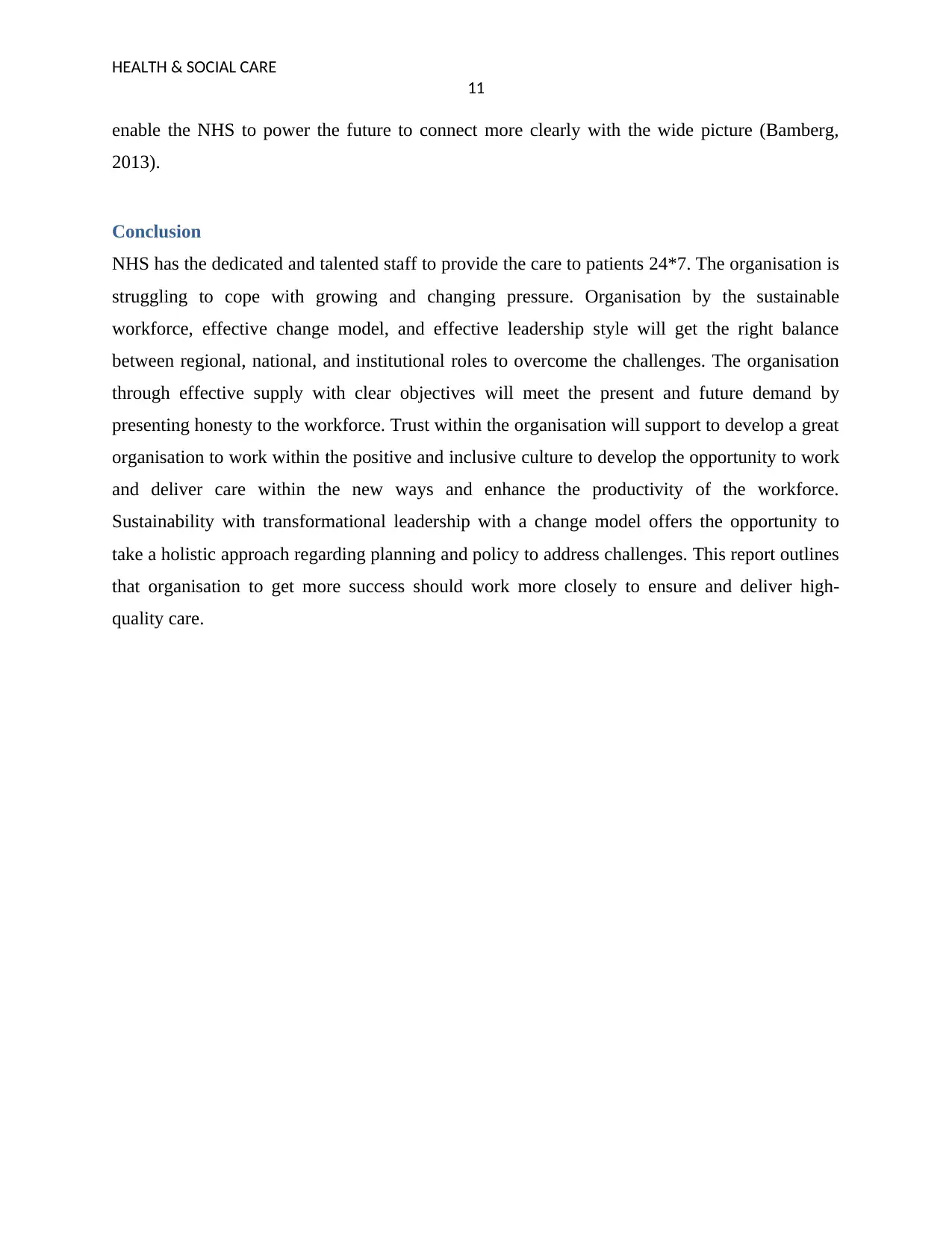
HEALTH & SOCIAL CARE
11
enable the NHS to power the future to connect more clearly with the wide picture (Bamberg,
2013).
Conclusion
NHS has the dedicated and talented staff to provide the care to patients 24*7. The organisation is
struggling to cope with growing and changing pressure. Organisation by the sustainable
workforce, effective change model, and effective leadership style will get the right balance
between regional, national, and institutional roles to overcome the challenges. The organisation
through effective supply with clear objectives will meet the present and future demand by
presenting honesty to the workforce. Trust within the organisation will support to develop a great
organisation to work within the positive and inclusive culture to develop the opportunity to work
and deliver care within the new ways and enhance the productivity of the workforce.
Sustainability with transformational leadership with a change model offers the opportunity to
take a holistic approach regarding planning and policy to address challenges. This report outlines
that organisation to get more success should work more closely to ensure and deliver high-
quality care.
11
enable the NHS to power the future to connect more clearly with the wide picture (Bamberg,
2013).
Conclusion
NHS has the dedicated and talented staff to provide the care to patients 24*7. The organisation is
struggling to cope with growing and changing pressure. Organisation by the sustainable
workforce, effective change model, and effective leadership style will get the right balance
between regional, national, and institutional roles to overcome the challenges. The organisation
through effective supply with clear objectives will meet the present and future demand by
presenting honesty to the workforce. Trust within the organisation will support to develop a great
organisation to work within the positive and inclusive culture to develop the opportunity to work
and deliver care within the new ways and enhance the productivity of the workforce.
Sustainability with transformational leadership with a change model offers the opportunity to
take a holistic approach regarding planning and policy to address challenges. This report outlines
that organisation to get more success should work more closely to ensure and deliver high-
quality care.
⊘ This is a preview!⊘
Do you want full access?
Subscribe today to unlock all pages.

Trusted by 1+ million students worldwide
1 out of 15
Related Documents
Your All-in-One AI-Powered Toolkit for Academic Success.
+13062052269
info@desklib.com
Available 24*7 on WhatsApp / Email
![[object Object]](/_next/static/media/star-bottom.7253800d.svg)
Unlock your academic potential
Copyright © 2020–2025 A2Z Services. All Rights Reserved. Developed and managed by ZUCOL.




